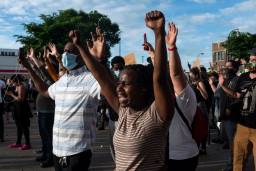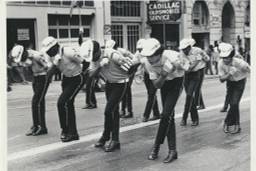Dylann Roof’s Rhodesian, South African Flags Symbolize White Supremacy. So Does the Confederate Flag
That a racist mass murderer would embrace of the three flags should end the debates about whether or not the Confederate flag can mean anything other than racism.
Peter Cole

Symbols matter. If they didn’t, we wouldn’t be in the midst of such acrimonious debate about the Confederate flag, 150 years after the end of the Civil War. Most of its defenders assert — disingenuously — that the flag has nothing to do with slavery and white supremacy, instead invoking notions of Southern pride or celebrations of Southern heritage. Ask the vast majority of African Americans about the Confederate flag, though, and there is no hesitation: it’s hateful, pure and simple. It represented, and still represents, the efforts by Southern whites to preserve the institution of slavery.
The long-running debate over the meaning of the Confederate flag started up again last week when a young white Southern man named Dylann Roof, who displayed it proudly in numerous photos before he brutally murdered nine innocent African Americans in Charleston, South Carolina.
A photograph also surfaced of Roof wearing a jacket emblazoned with two other flags stitched upon it representing two countries in southern Africa that no longer exist: Rhodesia and apartheid South Africa, both countries organized around a brutal system of white supremacy. Roof also had a personal website named the Last Rhodesian.
That a racist mass murderer would embrace of the flags of Rhodesia, apartheid South Africa and the Confederacy should end the debates about whether or not the Confederate flag can mean anything other than racism. The ties between white supremacy and the “stars and bars” are impossible to deny. An examination of those African countries’ histories, how they chose to deal with their flags in the era after state-sanctioned white supremacy and how white supremacists in recent years have continued to embrace all three symbols helps show why.
The legacy of apartheid and white supremacy in southern Africa
Pre-1994 South Africa and Rhodesia both operated under horrific systems of racial oppression.
South Africa was colonized in the 1600s by the Dutch and, later, by the British. These empires encouraged whites to “settle” in southern Africa. In the early 20th century, there were more than a million whites in South Africa and about five million blacks, Asians and mixed race people (“coloured” in South African parlance). However, despite making up about 80% of the population, only whites were considered citizens.
Whites controlled the economic and political levers of power — and did so ruthlessly. After World War II, South Africa’s white population voted in a political party, the Nationalists, that swiftly moved to further enshrine white supremacist apartheid. Think close to Nazi-style fascism in southern Africa.
Apartheid South Africa was stunning in its overt racism. All people had to register and were identified as belonging to one of the four races. No one could marry or have sex with anyone from another race. Black people (as well as Asians and coloureds) had to live in homogeneous suburban “townships” and rural “reserves.” Most jobs were denied to blacks. Eighty-seven percent of the land already had been reserved for the then-15% of the white population — including the most arable land as well as any that had gold or diamonds underneath it.
Blacks and other non-Europeans, as they also were called, could not vote, could not serve on juries and had no real protection in the courts. Blacks could not relocate, if they wished to; instead, blacks had to get permission from the state to move to another part of the country — and then only if she or he could prove employment by a white boss.
In cities and the countryside, every day and always, blacks had to carry passes; any white could ask any black for a pass. Literally hundreds of thousands of blacks were arrested for violations of the pass laws, often being sent back to the barren, overpopulated, destitute reserves. Blacks who protested — and tens of thousands did — were systematically jailed, banned, killed, or went into exile by the mid-1960s.
In some ways, Rhodesia was worse. Fifteen percent of South Africa’s population was white, but that number was less than 4 percent in early 20th century Rhodesia, also a British colony. Rhodesia was named after the British imperialist and racist Cecil Rhodes, who made one of the largest fortunes in the 19th century world by tapping the mineral wealth of the region. In the 19th century, the British actually named two of its colonies after Rhodes: Southern Rhodesia became Zimbabwe and Northern Rhodesia now is called Zambia.
In America, though, Cecil Rhodes is best known for the educational program he endowed for college graduates from the U.S., Germany and British Commonwealth nations to study in the United Kingdom, Rhodes Scholars. Of course, Rhodes funded this program by plundering the wealth and oppressing literally millions of black people across southern Africa. He saw the program as a way to tie together what he considered future leaders of the “great powers”: the U.S., U.K. and Germany.
In 1965, Rhodesia’s miniscule white minority declared their independence from Britain and thereafter deployed brutal force to maintain an oppressive white supremacist regime. Almost immediately, black revolutionaries emerged and began a 15 year-long armed struggle that ultimately succeeded in winning freedom in 1980. Not surprisingly, when the new regime instituted democracy and equal rights for all (including for whites, though many of them left), the hated name Rhodesia was discarded.
Instead, the new nation chose to honor parts of its incredible heritage by naming itself after the Great Zimbabwe, a city of massive stone structures. This place, perhaps the home of the legendary Queen of Sheba, is called Zimbabwe in Shona (Shona people make up about 80% of the nation) and means “houses of stone.” Zimbabweans also abandoned a flag that incorporated both British imperialism and the Rhodes’ family crest for one that celebrated the black majority, their heritage and struggle for freedom, and the richness of their land.
South Africa’s freedom struggle, the anti-apartheid movement, took much longer and was perhaps the greatest global social movement in the second half of the 20th century. Despite massive, brutal repression, blacks, coloureds, Asians, and some whites fought for decades to overcome apartheid — at stunning cost.
Nelson Mandela, imprisoned for life but released after 27 years, was only one of many tens of thousands imprisoned for wanting equal rights. The end of apartheid in 1994, marked by the first multiracial elections in South African history, is considered one of proudest moments of any country in modern human history. The new South Africa, often referred to as the “rainbow nation,” also created a new, multicolored flag that spoke to the multiracial state.
According to the South African government, “The central design of the flag, beginning at the flagpost in a ‘V’ form and flowing into a single horizontal band to the outer edge of the fly, can be interpreted as the convergence of diverse elements within South African society, taking the road ahead in unity.”
In essence, after the end of the white supremacist regimes, both of these countries recognized that their old flags symbolized hate and horror. Citizens realized they had to create new flags to represent new, democratic nations. When blacks finally gained equal political rights in these two nations, the racist symbols of the past were consigned to the proverbial dustbin of history.
No Lessons Learned in America
Whereas the newly empowered black majorities in both South Africa and Zimbabwe attacked obvious symbols of the old, racist regimes, the United States ended up taking a very different path. Almost immediately after the Civil War, many Southern whites constructed a narrative in which they were the victims and set about romanticizing their “Lost Cause.”
The Confederate battle flag was one symbol of this ideal. But it took the modern-day civil rights movement, in the 1950s and 1960s, for some Southern whites to resurrect this flag in order to express their defiance of black equality. A glance at many of the photographs from the civil rights era confirm that the Confederate flag was deployed by those who tried — and failed — to maintain Jim Crow segregation.
In Zimbabwe and South Africa, no one would insist that use of the apartheid-era flags were anything other than apologia for white supremacy. However, in the U.S., perhaps because a few generations have passed since the civil rights era and a century and half has passed since the end of the Civil War, some whites still assert that the Confederate flag is not a hateful and racist symbol.
Further, most Republican leaders — most notably those running for president next year — refused to name this crime as racist or promote the idea that this symbol represents the discarded notion of White supremacy. (South Carolina Governor Nikki Haley just called for this flag to be removed from the South Carolina capitol, albeit only after fiercely resisting to do so for days and initially suggesting that the murder was more likely an attack on Christians than blacks.)
But it’s obvious that anyone who would wear or fly the flag of an old regime based on legalized racial inequality is basically saying, “I wish we could return to an earlier time, when I lived in a nation that denied black people equal rights.”
That is what many South Africans thought when they heard about Dylann Roof. For instance, in the words of Dave Steward, director of the F.W. de Klerk Foundation, named after the last white head of state of apartheid South Africa, “It remains to be established why the alleged perpetrator was wearing old South African and Rhodesian flags in one of his Facebook photos. Whatever the reason, he is deeply mistaken if he imagines anyone in South Africa — from across the political spectrum — would have any reaction other than the deepest revulsion to the cold-blooded killing of innocent worshippers.”
The Danger of the Flag
We must know this history in order to understand Dylann Roof and the white Americans who continue to demonstrate sympathy for the Confederate cause, which was to protect slavery from abolition, and its flag. Because like Roof, who adorned himself with the flags of these two horrid, racist regimes and named his website the Last Rhodesian, many white people outside of southern Africa look upon Rhodesia and apartheid-era South Africa with nostalgia and with regret for their passing into oblivion.
As historian Gerald Horne has documented, tens of thousands of white Americans, especially in the South, looked at Rhodesia during the 1970s with love and affection. Several organizations existed including the 25,000 Americans who belonged to the Friends of Rhodesian Independence. As Horne writes in his book on U.S.-Zimbabwean relations, “One voter in Georgia told the segregationist Senator Eugene Talmadge, ‘To say that I admire the Anglo-Saxon Rhodesians is putting it mildly. I wish we had a very hundred thousand of them here’!”
Much more recently, the notorious Klansman and Louisiana politician David Duke expressed sympathy for white South Africans and apartheid: “The white people made a great nation of South Africa and black people thrived and prospered there” — a sentiment that sounds exactly like white Southern slaveholders who claimed that slavery was good for enslaved black people.
Today, some white people from Rhodesia/Zimbabwe also lament the passing of their nation from white minority to black majority, democratic rule. Martha Evans, a faculty member at the University of Cape Town, has documented how some white South Africans possess nostalgia for apartheid-era South Africa; in a way, that comes as little surprise as whites in both nations had among the highest standards of living in the world due to their ability to exploit millions of black Africans.
Based upon his “manifesto,” Roof appears to be admire white supremacist regimes in southern Africa, but not for the economic benefits of super-exploitation. Rather, he boasted that “white culture” was, simply, superior: “Many white people feel as though they dont have a unique culture. The reason for this is that White culture is world culture. I dont mean that our culture is made up of other cultures, I mean that our culture has been adopted by everyone in the world. This makes us feel as though our culture isnt special or unique.”
And, of course, he literally waved the Confederate flag in many photos that he uploaded to his website, purchased his (state-sanctioned) South Carolina Confederate license plate, visited Civil War battlefield and slave sites, and paid homage to the Confederacy.
Dylann Roof knew exactly what the Confederate flag meant. It meant the same thing that the Rhodesian and apartheid South Africa flags meant: a commitment to reshape the country based on the ideals of white supremacy. Just as anyone who waves those flags in South Africa or Zimbabwe should be assumed to be looking to restore those viciously racist regimes, so should we assume that anyone in the United States is interested not in notions of “heritage” or “Southern pride,” but in restoring the viciously racist Confederate regime.
In the past few months, there has been a massive and somewhat successful effort to revisit the legacy of Cecil Rhodes in South Africa. Led by black university students, in a way reminiscent of the U.S. #BlackLivesMatter movement, University of Cape Town students created the #RhodesMustFall campaign, resulting in the eventual tear-down of the statue of Rhodes at UCT and setting off an ongoing national conversation about how old racist symbols must be obliterated — for only then can white supremacy truly be rooted out.
Perhaps we can learn something from these symbolic actions by South African students. White Americans can’t hide behind the fiction that the Confederate flag — or any of the other Confederate monuments throughout the South — are symbols of anything other than racism. Dylann Roof, if nothing else, has re-opened a much-needed conversation: to combat racism, one must eradicate and denigrate all such obvious symbols of white supremacy. The Confederate flag is one such symbol. If we’re going to eradicate racism, we’ll have to eradicate that flag.







